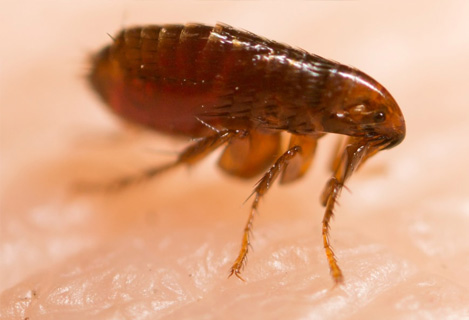
Eliminating a flea infestation will mean treating all places that can be infested, including your pet, your home and your yard. Failing to treat all of the areas will likely lead to treatment failure. We recommend starting with your pets and then treating the home and yard. The treatments should be done around the same time for the best results.
Fleas are outdoor parasites that live by feeding on blood off mammals and birds. Adult fleas are very small insects (about 1/16” long), dark reddish-brown and wingless. They have three pairs of legs, and their longer back legs make them excellent jumpers. Fleas can jump thirteen feet horizontally and seven feet vertically. The flea’s body is hard and covered with hairs and spines projecting backward, and they have a piercing-sucking mouthpart used to obtain blood meals from a host.
The most frequently found flea in the world is the pet flea.Its primary host is the domestic pets at home, and it is also the most common flea found on domestic cats. These fleas attach themselves to the host’s eyes and ears. Other popular fleas are the human flea (Pulex irritans), the northern rat flea (Nosopsyllus fasciatus) and the oriental rat flea (Xenspsylla cheopis).
A flea’s life cycle consists of egg, larva, pupa and adult, and the entire cycle can vary from two weeks to eight months depending on species, humidity, temperature and food. (The life cycle of a cat flea up to adulthood at room temperature takes about eighteen days.) Normally, after the female has a blood meal, she will lay between fifteen to twenty oval, white eggs per day on the host. Once the eggs dry they will usually drop off the host where it rests (carpet, upholstered furniture, cat or dog boxes, etc.). Eggs hatch into white, worm-like larvae in two days to two weeks.
The flea larvae phase consists of three stages, which last a week to several months. The larvae mostly feed on the dried blood found in the fecal matter of the adult fleas which falls off the host. Larval development normally occurs in places where there is at least 75% humidity, and larvae develop more quickly in warmer temperatures (70 to 90 F).
Once the larval stage is completed, the larva spins a tiny, silken cocoon and pupates. The pupae is usually camouflage by local debris. The larva will mature to adulthood inside its cocoon in about five to fourteen days. Since the new flea can only live a week without a blood meal, it will remain in its cocoon until it detects a host through vibration (people or pets walking), pressure (a host laying down on them), noise, heat or carbon dioxide. This is one reason why a family returning to an unoccupied home after an extended period of time (a long vacation) may suddenly be attacked by a massive amount of fleas. Newly emerged fleas will jump on a host only minutes after leaving their cocoon and begin feeding. An adult cat flea will normally live for thirty to forty days.
Fleas Control often breed most heavily where pets and other animals rest. Fleas may be found on pets throughout the year, but tend to be most problematic during spring and early summer. Pets infested with fleas are incessantly biting and scratching themselves. Humans are affected by flea bites differently depending on their sensitivity to the flea saliva. Fleas tend to bite humans on the ankles or lower leg and leave a small, red, itchy bump. People with allergies to the saliva, or flea allergic dermatitis (FAD), will experience extreme itching, and often a secondary infection is caused by the constant scratching.
1) The single primary deterrent of egg production is the grooming habits of the pets. Cats are the best groomers and they ingest up to 50% of the fleas on them.
2) The larva stage of the life cycle is typically 7 to 11 days.
3) The larva undergoes a huge change in body size in five to six days and during its life cycle spins a silk cocoon.
4) The larva can crawl up to three feet in distance.
5) In order for the Cat flea to survive, it must have a minimum of 30% humidity. The larva is negative phototaxis, which means it does not like light. The larva is also positive geotaxis, meaning it moves downward. These are two reasons why larva are found in the base of carpets.
6) The primary reason flea infestations vary is the amount of humidity. Carpet helps protect the humidity surrounding the larva.

He is truly passionate about his work and offers honest advice. He is also extremely respectful of other people's property. All of these qualities are very rare nowadays so I will definitely be using his services annually. Thanks

He was very professional and he also adviced us on our pool gate that was not in working order that we did not know about we have two young children and this was not part of his job so this really impressed us. Thank you Sonny

Fantastic service with Immediate results. You won't be disappointed. He was very friendly, informative & did an awesome job today. I'll recommend Sydney's with pest away pest control to everyone I know. Thank You ?

I have done a pest control with pest away pest control. It is very worthwhile, reliable and the person who came (Mr Omar) to do the job is very friendly and did the job very well. I recommend this company to any body who want to do a good job and worth for the money you are paying.

A knowledgable, friendly and efficient service with pest away pest control. It's so refreshing to get an honest appraisal rather than one that is only based on profit. We will definitely use them again.

Pestawaypestcontrol is one of the most helpful and supportive professionals I have ever met. He will go out of his way to assist you and ensure you receive the best advice regarding the most effective pest control methods available. I would thoroughly recommend Sydneys Pest Control without hesitation.

He was very professional and he also adviced us on our pool gate that was not in working order that we did not know about we have two young children and this was not part of his job so this really impressed us. Thank you Sonny

A company offering free advice, without pushing for business, is very refreshing. After examining photos of a pest problem I was experiencing, Pest away pest control , phoned me to discuss the matter. His advice was to take my photos to my local hardware store to obtain the correct product to treat the problem myself. There was no pressure to use the services of his company. I was very impressed with knowledge and professionalism. After this experience, I would certainly use the company for my annual pest control treatment.

He is truly passionate about his work and offers honest advice. He is also extremely respectful of other people's property. All of these qualities are very rare nowadays so I will definitely be using his services annually. Thanks
